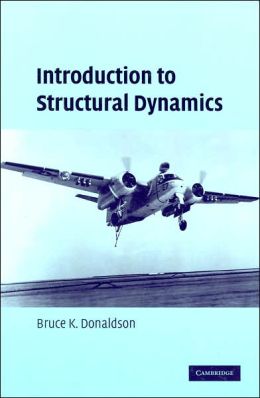 [内容简介]
[内容简介]
This textbook provides the student of aerospace, civil, or mechanical engineering with all the fundamentals of linear structural dynamics analysis and scattered discussions of non-linear structural dynamics, it is designed to be used primarily for a first-year graduate course. This textbook is a departure from the usual presentation of this material in two important respects. First, descriptions of system dynamics throughout are based on the simpler-to-use Lagrange equations of motion. Second, no organizational distinction is made between single- and multiple-degree-of-freedom systems. In support of these two choices, the first three chapters review the needed skills in dynamics and finite element structural analysis. The remainder of the textbook is organized mostly on the basis of first writing structural system equations of motion, and then solving those equations. The modal method of solution is emphasized, but other approaches are also considered. This textbook covers more material than can reasonably be taught in one semester. Topics that can be put off for later study are generally placed in sections designated by double asterisks or in endnotes. The final two chapters can also be deferred for later study. The textbook contains numerous example problems and end-of-chapter exercises.
[目录]
Preface for the Student xi
Preface for the Instructor xv
Acknowledgments xvii
List of Symbols xix
The Lagrange Equations of Motion 1
Introduction 1
Newton's Laws of Motion 2
Newton's Equations for Rotations 5
Simplifications for Rotations 8
Conservation Laws 12
Generalized Coordinates 12
Virtual Quantities and the Variational Operator 15
The Lagrange Equations 19
Kinetic Energy 25
Summary 29
Exercises 33
Further Explanation of the Variational Operator 37
Kinetic Energy and Energy Dissipation 41
A Rigid Body Dynamics Example Problem 42
Mechanical Vibrations: Practice Using the Lagrange Equations 46
Introduction 46
Techniques of Analysis for Pendulum Systems 47
Example Problems 53
Interpreting Solutions to Pendulum Equations 66
Linearizing Differential Equations for Small Deflections 71
Summary 72
**Conservation of Energy versus the Lagrange Equations** 73
**Nasty Equations of Motion** 80
**Stability of Vibratory Systems** 82
Exercises 85
The Large-Deflection, Simple Pendulum Solution 93
Divergence and Flutter in Multidegree of Freedom, Force Free Systems 94
Review of the Basics of the Finite Element Method for Simple Elements 99
Introduction 99
Generalized Coordinates for Deformable Bodies 100
Element and Global Stiffness Matrices 103
More Beam Element Stiffness Matrices 112
Summary 123
Exercises 133
A Simple Two-Dimensional Finite Element 138
The Curved Beam Finite Element 146
FEM Equations of Motion for Elastic Systems 157
Introduction 157
Structural Dynamic Modeling 158
Isolating Dynamic from Static Loads 163
Finite Element Equations of Motion for Structures 165
Finite Element Example Problems 172
Summary 186
**Offset Elastic Elements** 193
Exercises 195
Mass Refinement Natural Frequency Results 205
The Rayleigh Quotient 206
The Matrix Form of the Lagrange Equations 210
The Consistent Mass Matrix 210
A Beam Cross Section with Equal Bending and Twisting Stiffness Coefficients 211
Damped Structural Systems 213
Introduction 213
Descriptions of Damping Forces 213
The Response of a Viscously Damped Oscillator to a Harmonic Loading 230
Equivalent Viscous Damping 239
Measuring Damping 242
Example Problems 243
Harmonic Excitation of Multidegree of Freedom Systems 247
Summary 248
Exercises 253
A Real Function Solution to a Harmonic Input 260
Natural Frequencies and Mode Shapes 263
Introduction 263
Natural Frequencies by the Determinant Method 265
Mode Shapes by Use of the Determinant Method 273
**Repeated Natural Frequencies** 279
Orthogonality and the Expansion Theorem 289
The Matrix Iteration Method 293
**Higher Modes by Matrix Iteration** 300
Other Eigenvalue Problem Procedures 307
Summary 311
**Modal Tuning** 315
Exercises 320
Linearly Independent Quantities 323
The Cholesky Decomposition 324
Constant Momentum Transformations 326
Illustration of Jacobi's Method 329
The Gram-Schmidt Process for Creating Orthogonal Vectors 332
The Modal Transformation 334
Introduction 334
Initial Conditions 334
The Modal Transformation 337
Harmonic Loading Revisited 340
Impulsive and Sudden Loadings 342
The Modal Solution for a General Type of Loading 351
Example Problems 353
Random Vibration Analyses 363
Selecting Mode Shapes and Solution Convergence 366
Summary 371
**Aeroelasticity** 373
**Response Spectrums** 388
Exercises 391
Verification of the Duhamel Integral Solution 396
A Rayleigh Analysis Example 398
An Example of the Accuracy of Basic Strip Theory 399
Nonlinear Vibrations 400
Continuous Dynamic Models 402
Introduction 402
Derivation of the Beam Bending Equation 402
Modal Frequencies and Mode Shapes for Continuous Models 406
Conclusion 431
Exercises 438
The Long Beam and Thin Plate Differential Equations 439
Derivation of the Beam Equation of Motion Using Hamilton's Principle 442
Sturm-Liouvilie Problems 445
The Bessel Equation and Its Solutions 445
Nonhomogeneous Boundary Conditions 449
Numerical Integration of the Equations of Motion 451
Introduction 451
The Finite Difference Method 452
Assumed Acceleration Techniques 460
Predictor-Corrector Methods 463
The Runge-Kutta Method 468
Summary 474
**Matrix Function Solutions** 475
Exercises 480
Answers to Exercises 483
Solutions 483
Solutions 486
Solutions 494
Solutions 498
Solutions 509
Solutions 516
Solutions 519
Solutions 525
Solutions 529
Fourier Transform Pairs 531
Introduction to Fourier Transforms 531
Index 537

 新书报道
新书报道